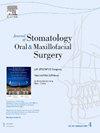Application of recombinant human epidermal growth factor in oral and maxillofacial trauma and its impact on healing time
IF 2
3区 医学
Q2 DENTISTRY, ORAL SURGERY & MEDICINE
Journal of Stomatology Oral and Maxillofacial Surgery
Pub Date : 2025-10-01
DOI:10.1016/j.jormas.2025.102326
引用次数: 0
Abstract
Objective
This study aimed to investigate the role of recombinant human epidermal growth factor (rhEGF) in promoting the healing of oral and maxillofacial (OMF) trauma, analyze its specific impact on healing time, and explore the biological mechanisms of rhEGF in facilitating wound recovery.
Methods
A retrospective analysis was conducted on 135 patients with OMF trauma treated at our hospital from May 2023 to May 2024. Patients were divided into an observation group (72 cases) receiving rhEGF treatment and a control group (63 cases) receiving conventional therapy. Clinical efficacy, inflammatory responses, perioperative indicators, and other outcomes were compared between the two groups.
Results
The observation group demonstrated a higher treatment efficacy rate (94.46 %) compared to the control group (77.78 %) (χ² = 16.151, P < 0.001). In the perioperative period, the observation group exhibited shorter healing time (t = 6.038, P < 0.001), reduced incision edema duration (t = 12.330, P < 0.001), and lower post-treatment VAS scores (t = 10.400, P < 0.001), though surgical duration was slightly longer (t = -24.145, P < 0.001). Inflammatory marker analysis revealed that EGF levels were higher (t = -13.969, P < 0.001), while IL-6 (t = 10.458, P < 0.001) and CRP levels (t = 14.092, P < 0.001) were lower in the observation group than in the control group. Scar hyperplasia occurred in only 2 cases in the observation group compared to 13 cases in the control group (χ² = 10.848, P < 0.001).
Conclusion
rhEGF promotes wound healing in OMF trauma, accelerating recovery, shortening healing time, reducing inflammatory responses, and minimizing scar hyperplasia.
重组人表皮生长因子在口腔颌面创伤中的应用及其对愈合时间的影响。
目的:本研究旨在探讨重组人表皮生长因子(rhEGF)促进口腔颌面部(OMF)创伤愈合的作用,分析其对愈合时间的具体影响,并探讨rhEGF促进伤口愈合的生物学机制。方法:回顾性分析2023年5月至2024年5月在我院治疗的135例OMF创伤患者。患者分为观察组(72例)接受rhEGF治疗,对照组(63例)接受常规治疗。比较两组患者的临床疗效、炎症反应、围手术期指标等结果。结果:观察组治疗有效率(94.46%)高于对照组(77.78%)(χ² = 16.151,P < 0.001)。围手术期观察组愈合时间较短(t = 6.038,P < 0.001),切口水肿持续时间较短(t = 12.330,P < 0.001),术后VAS评分较低(t = 10.400,P < 0.001),手术时间稍长(t = -24.145,P < 0.001)。炎症标志物分析显示,观察组EGF水平高于对照组(t = -13.969,P < 0.001), IL-6 (t = 10.458,P < 0.001)和CRP水平(t = 14.092,P < 0.001)低于对照组。观察组瘢痕增生2例,对照组13例(χ² = 10.848,P < 0.001)。结论:rhEGF促进OMF创伤创面愈合,加速恢复,缩短愈合时间,减轻炎症反应,减少瘢痕增生。
本文章由计算机程序翻译,如有差异,请以英文原文为准。
求助全文
约1分钟内获得全文
求助全文
来源期刊

Journal of Stomatology Oral and Maxillofacial Surgery
Surgery, Dentistry, Oral Surgery and Medicine, Otorhinolaryngology and Facial Plastic Surgery
CiteScore
2.30
自引率
9.10%
发文量
0
审稿时长
23 days
 求助内容:
求助内容: 应助结果提醒方式:
应助结果提醒方式:


